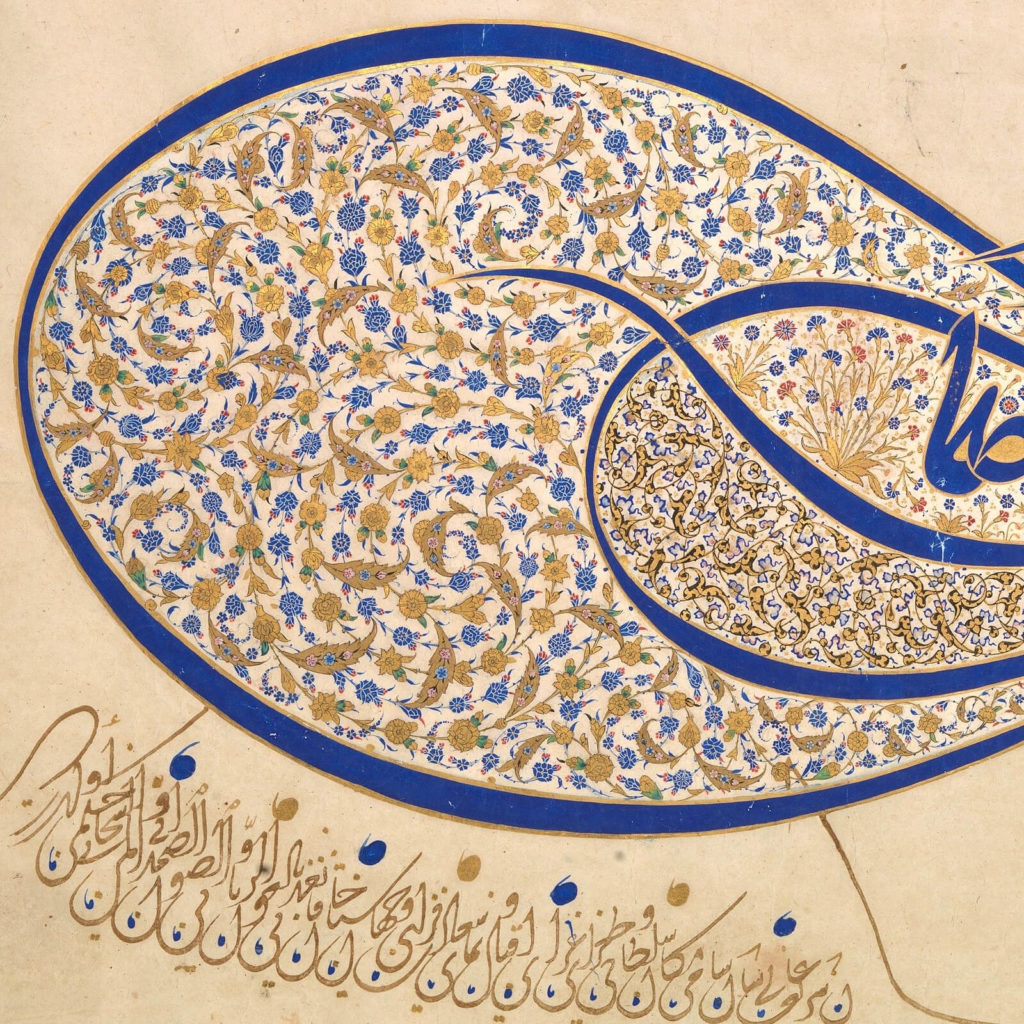Masterpiece Story: Dynamism of a Dog on a Leash by Giacomo Balla
Giacomo Balla’s Dynamism of a Dog on a Leash is a masterpiece of pet images, Futurism, and early 20th-century Italian...
James W Singer, 23 February 2025
7 August 2022 min Read
During the 16th and 17th centuries, The Ottoman Empire reached the height of its powers and extended into several continents, crossing nations and languages. It encompassed the northern shore of Africa, the Middle East, and southeastern Europe. Ruling at the pinnacle of this vast and wealthy empire was the sultan, and its most famous sultan was Süleiman the Magnificent. He was a fabulous patron of the arts, and Tughra of Sultan Süleiman the Magnificent is one of his many examples. Let us explore this Ottoman image. Let us explore this Ottoman painting.

A tughra is a sultan’s official emblem used on all official documents, such as royal decrees, grants, and correspondence. It blends the pictorial nature of a royal seal with the written nature of a royal signature. The tughra is the symbol of the sultan’s authority just as a crown or throne is the symbol of a European monarch.
However, unlike a European crown or throne that may remain constant through many successive reigns, the tughra was personalized for each Ottoman sultan. The Ottoman sultan would design his own version of the tughra on his ascension and would use this personal tughra consistently throughout his reign. The tughra featured here is the Tughra of Sultan Süleiman the Magnificent and it is truly magnificent in its design!

Sultan Süleiman the Magnificent ruled the Ottoman Empire from 1520 to 1566. The tughra featured in today’s article dates late in his reign from c. 1555 to 1560. Tughra of Sultan Süleiman the Magnificent has a mature style with the boldness of its lines, colors, and complexity. This example is not of the simplistic tughras of earlier and less sophisticated reigns. The first tughra was invented by Süleiman the Magnificent’s ancestor, Sultan Orhan Gazi, in 1324. Sultan Orhan Gazi’s tughra is simplistic in comparison with its single use of black ink. It has a more utilitarian feel like a modern signature compared to the floral and gilt beauty of Tughra of Sultan Süleiman the Magnificent.

The elaborate design of Tughra of Sultan Süleiman the Magnificent is developed through the use of cobalt blue ink; watercolors of cerulean blue, rose pink, and moss green; and gold leaf. Horror vacui, or fear of the empty, is used throughout the composition as every space is filled with flowers, leaves, and spirals. There is barely any negative space within the tughra.
However, the organic motifs do not render the tughra as too busy or jarring to the eyes. Actually, the delicate blossoms and fronds contrast nicely with the bold strokes of the ink brush. They add a sense of scale to the work allowing the blue lines to seem bolder and more powerful when compared to the dainty patterns. Harmony is achieved through its sympathetic patterns and complementary colors.

The use of roses, carnations, saz leaves, and plant scrolls makes the Tughra of Sultan Süleiman the Magnificent a perfect example of the Saz Style. The style was popular in 16th century Ottoman art, and is known for its vibrant floral compositions against pale backgrounds. The splendor of the style is added by an Arabic inscription appearing on the bottom left corner. It is written from right to left and it can be translated into English as “Sultan Süleiman, son of Sultan Selim Khan, ever victorious.” It highlights Süleiman the Magnificent’s lineage through his father while praising his own glorious reign. It also adorns the page with pure elegance in gold.
There is an ancient Arabic proverb that states, “Purity of writing is purity of soul.” Perhaps when Süleiman the Magnificent commissioned his tughra, he was trying to achieve purity of soul. No matter the intentions, the sophisticated Tughra of Sultan Süleiman the Magnificent is a powerful symbol of the once mighty Ottoman Empire. It is an Ottoman image, an Ottoman painting.
Denny, Walter B., “Tughra of Sultan Süleiman the Magnificent”, The Metropolitan Museum of Art. Accessed April 12, 2020.
“In Praise of Allah: The Art of the Islamic World”, in Gardner’s Art Through the Ages, 12th ed., 367. Belmont, CA: Thomson Learning, Inc., 2005.
“Tughra of Sultan Süleiman”, in 10,000 Years of Art, 337, London: Phaidon Press Limited, 2009.
DailyArt Magazine needs your support. Every contribution, however big or small, is very valuable for our future. Thanks to it, we will be able to sustain and grow the Magazine. Thank you for your help!